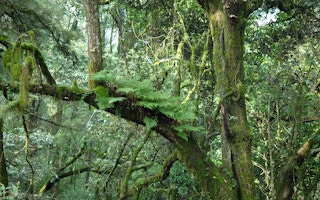British and US scientists think there may be a connection between global heating driven by profligate fossil fuel use, and the emergence of the bat-borne virus that has triggered a global pandemic and has so far claimed more than two million lives worldwide − in short, a possible climate link to Covid-19.
The connection is possibly quite simple. Rising average temperatures encouraged a change in the natural vegetation of the forests of Yunnan, the southern Chinese province, close to the forests of Laos and Myanmar.
What had been tropical shrubland shifted to tropical savannah and deciduous woodland: the province became a suitable habitat for many bat species. It is also home to the scaly anteater known as the pangolin, and the masked palm civet: both of these have been also proposed as intermediate carriers of the virus.
And, researchers say, in the last century an additional 40 bat species moved into Yunnan: these may have delivered 100 more types of bat coronavirus to the pool of potential infection.
“
The fact that climate change can accelerate the transmission of wildlife pathogens to humans should be an urgent wake-up call to reduce global emissions.
Camilo Mora, associate professor, department of geography and environment, University of Hawaii
Magnet for bats
And this “global hotspot” − far from the city where the first human cases were first confirmed − is where all the genetic data suggest that the coronavirus known as SARS-CoV-2 may have arisen, says a study in the journal Science of the Total Environment.
“Climate change over the last century has made the habitat in Yunnan province suitable for more bat species,” said Robert Beyer of the University of Cambridge, now at the Potsdam Institute for Climate Impact Research in Germany, who led the research.
“Understanding how the global distribution of bat species has shifted as a result of climate change may be an important step in reconstructing the origin of the Covid-19 outbreak.”
That animals carry viruses which can infect other species is well established: the HIV-Aids pandemic, the Ebola outbreaks in Africa and many other infections have all been linked to animal-to-human transmission.
For decades, scientists have been recording new “zoonotic” or animal-borne diseases in humans at the rate of two a year. An estimated 80% of all the viruses linked to human disease are of animal origin, including rabies.
The link between human disturbance of wilderness and disease outbreak has been made before, and more than once. A study by Cambridge scientists last year identified 161 steps humankind could take to reduce the ever-growing risks of zoonotic infection that could lead to even more devastating pandemics.
The case for bat transmission of SARS-CoV-2 driven by climate change remains circumstantial. It identifies a suspect and a set of possibly incriminating connections, but does not deliver the evidence for a secure conviction.
Using global records of temperature, rainfall and cloud cover, the scientists behind the latest study mapped global vegetation as it must have been a century ago. Then they used what they knew of the ecology of the world’s bat species to estimate the global distribution of each species 100 years ago. And then they matched this with records of species distribution in the last decade.
“As climate change altered habitats, species left some areas and moved into others − taking their viruses with them. This not only altered the regions where viruses are present, but most likely allowed for new interactions between animals and viruses, causing more harmful viruses to be transmitted or evolve,” Dr Beyer said.
There are more than 1,400 species of bat worldwide: these carry around 3,000 kinds of coronavirus, in ways that are mostly harmless to the host.
Risk increases
If the number of bat species increases, in a region also occupied by humans, then the risk of the infection of a new host, via bat urine, faeces, saliva or other transmission, also increases.
Bat viruses have been linked to Middle East Respiratory Syndrome, or MERS, and Severe Acute Respiratory Syndrome Cov-1 and CoV-2.
The region of Yunnan identified as now richer in bat species is also home to the pangolin, and one theory is that the virus jumped from bat to pangolin, or bat to masked palm civet, and then to humans when a pangolin was sold at a wildlife market in Wuhan, in Hubei province, more than 1200 kilometres away, where the first cases of Covid-19 were detected..
The implication of such a research finding is that, if human disturbance of the natural world increases the chance of such animal-to-human infection, then it will happen again. And it could happen with even greater potential loss of life.
That is why the discovery of this possible climate link to Covid-19 will now attract the minutest attention not only of scientists but of policymakers across the world.
“The fact that climate change can accelerate the transmission of wildlife pathogens to humans should be an urgent wake-up call to reduce global emissions,” said Camilo Mora, of the University of Hawaii, another of the research team.
This story was published with permission from Climate News Network.












